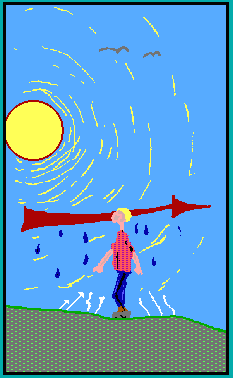HUMAN COMFORT
- GOAL:
- To understand how air temperature, humidity, mean radiant temperature (MRT), wind and sunshine affect human comfort.
- OBJECTIVE:
- The student will be able to:
- 1. Describe ways that the human body reacts while seeking its comfort zone.
- 2. Explain how air temperature, mean radiant temperature, humidity, wind, and sun affect human comfort.
- 3. Use the comfort zone chart correctly.
- LESSON/INFORMATION:
- The weather is always changing. As winter approaches, the rabbits shed old fur and grow a new heavier pelt, birds fly south, and bears hibernate. When trying to maintain a body temperature close to 98.6°F, humans have few natural controls with which to adapt to these changes in climate.
- The human body has three mechanisms to maintain this narrow temperature range. The first is heat generated inside the body, the second is by gaining heat from surroundings, and the third is by losing heat to the surroundings. The body automatically makes constant changes to control these three mechanisms and regulate body temperature.
- The following are a few of the ways the body responds in order to stay within the comfort zone:
- Shivering -

- Increased muscle activity and a higher metabolic rate increases internal heat production.
- Sweating -

- Moisture moves to the skin surface to be evaporated to lower body temperature.
- Goose Bumps -

- Body hair is fluffed up to provide better insulation to prevent heat loss.
- Blood Flow -
- Reduced flow to the hands, feet and skin surface in the winter to reduce heat loss to surroundings and an increase in blood flow to these areas in the summer to encourage heat loss.
- Factors Affecting Human Comfort Include:
- Air temperature is the most significant ambient factor which affects our internal temperature and our level of comfort. But, it is not the only factor involved; air speed, humidity and mean radiant temperature must also be considered. Each of these four factors has a direct influence on the rate at which the body loses or gains heat to or from the surroundings.

- Air Temperature -
- This affects temperature difference between the body and the surroundings, consequently affecting the rate of heat loss or gain by convection.
- Air Speed -
- This affects the rate at which the body loses heat by convection. The chill factor is one way to quantify the effects of air speed on heat loss. An air temperature of 35°F and a wind speed of 20 miles/hour combine to give a wind chill temperature of 11.2°F. This means that a body exposed to 35°F air and 20 mile/hour wind loses heat at the same rate as a body exposed to 11.2°F and no wind. Air speed is also very important during summer when the body is trying to lose heat to maintain comfort.
- Mean Radiant Temperature (MRT) -
- MRT is the average of the surface temperature of the surroundings with which the body can exchange heat by radiant transfer. Radiant heat transfer to and from the body is quite apparent when sitting near a fireplace (high MRT) or large cold window area (low MRT).
- Humidity -
- Affects the rate at which the body loses heat by evaporation. During hot weather, high humidity increases discomfort by making it more difficult to evaporate perspiration into the air.
- An easy way of describing the effect of air temperature, humidity, MRT, wind and sunshine is the Bioclimate Chart below.

- (Fig. 1) The Bioclimate chart used with permission from the Department of Energy.
- The air temperature is plotted on the vertical axis and relative humidity on the horizontal axis. The shaded area near the center of the graph shows the combination of temperature and humidity which most humans would find comfortable during the summer if they are sitting in the shade. The dotted area shows the comfort zone for the winter. It is interesting to see that the human body can actually adjust somewhat to different seasons.
- The climatic elements around the comfort zone are shown by means of curves which indicate the nature of corrective measures necessary to restore the feeling of comfort at any point outside the comfort zone. For any point of known dry-bulb temperature and relative humidity which falls within the boundaries of the comfort zone, no corrective measures are needed.
- For example, at dry-bulb temperature, 73°F, relative humidity of 50%, no corrective measures are needed because this point falls within the comfort zone.
- At dry-bulb temperature, 78°F, relative humidity of 70%, it would require a wind speed of about 250 FPM to provide comfort.
- At dry-bulb temperature of 50°F, relative humidity of 55%, it would require 250 Btu/hr of sunshine to provide comfort.
- ACTIVITY 1:
- For the given conditions below, tell what corrective measures are required, if any, to provide human comfort.
-
|
|---|
| Dry- Bulb Temperature |
75° |
65° |
60° |
75° |
90° |
80° |
| Relative Humidity |
60% |
60% |
55% |
80% |
60% |
50% |
| Corrective Measures: |
a |
b |
c |
d |
e |
f |
- a._________________________
- b._________________________
- c._________________________
- d._________________________
- e._________________________
- f. _________________________
- ACTIVITY 2:
- 1. Explain how humidity affects human comfort in the summer.
- 2. Explain how wind or air speed affects human comfort in the winter.
- RECOMMENDED READING:
- E. Cazayoux, A. Hebert & D. Winn, Natural Louisiana Architecture, Louisiana Department of Natural Resources, Baton Rouge, LA, 1991
- V. Olgyay, Design With Climate, Princeton University Press, Princeton, NJ, 1973
- So. Solar Energy Center, Building with Passive Solar, United States Department of Energy, 1981
TEACHER'S NOTES
- Activity 1:
- a. None
- b. 50 Btu/Hr
- c. 125 Btu/Hr
- d. 200 Ft/Min
- e. 700 Ft/Min
- f. None
- Activity 2:
- Explain how humidity affects human comfort in summer:
- Humidity affects the rate at which the body loses heat by evaporation. During hot weather, high humidity increases discomfort by making it more difficult to evaporate perspiration into the air.
- Explain how wind or air speed affects human comfort in winter:
- This affects the rate at which the body loses heat by convection. The chill factor is one way to quantify the effects of air speed on heat loss.
Comments or questions to: TechAsmt@LA.GOV
Return to Comfort Menu









